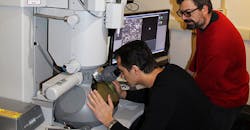Material engineers at Los Alamos National Laboratory have developed a tungsten-based alloy that can withstand unprecedented amounts of radiation without damage. This would make it an ideal choice for the interiors of magnetic fusion reactors. Materials previously explored for this purpose fracture too easily under similar conditions, but this new alloy seems to defeat that problem as well. Still, the team continues to investigate the material’s mechanical properties under different stress levels and responses to plasma exposure.
“This material showed outstanding radiation resistance when compared to pure nanocrystalline tungsten materials and other conventional alloys,” says Osman El Atwani, the principal investigator.
“But it seems we developed a material with unprecedented radiation resistance,” says Enrique Martinez Saez, another Los Alamos researcher. “We have never seen before a material that withstand the level of radiation damage we have observed for this high-entropy alloy. It seems to retain outstanding mechanical properties after irradiation, as opposed to traditional counterparts, in which the mechanical properties degrade easily under irradiation.” (High-entropy alloys contain four or more principal elements.)
The research team used atom-probe tomography to discover that, at the atomic level, the alloy contained layers of different elements which changed to nanoclusters when subjected to radiation. The scientist say this helped them understand why this alloy tolerates so much highly radiation.
The material, created as a thin film, is a quaternary nanocrystalline tungsten-tantalum-vanadium-chromium alloy that has been characterized under extreme thermal conditions and after irradiation.
The team hasn’t tested its corrosion resistance yet, but they anticipate it should perform well there also. Then, if it is shown to be ductile (as is also expected), it could be made into turbines because it is a refractory, high-melting-point material.

